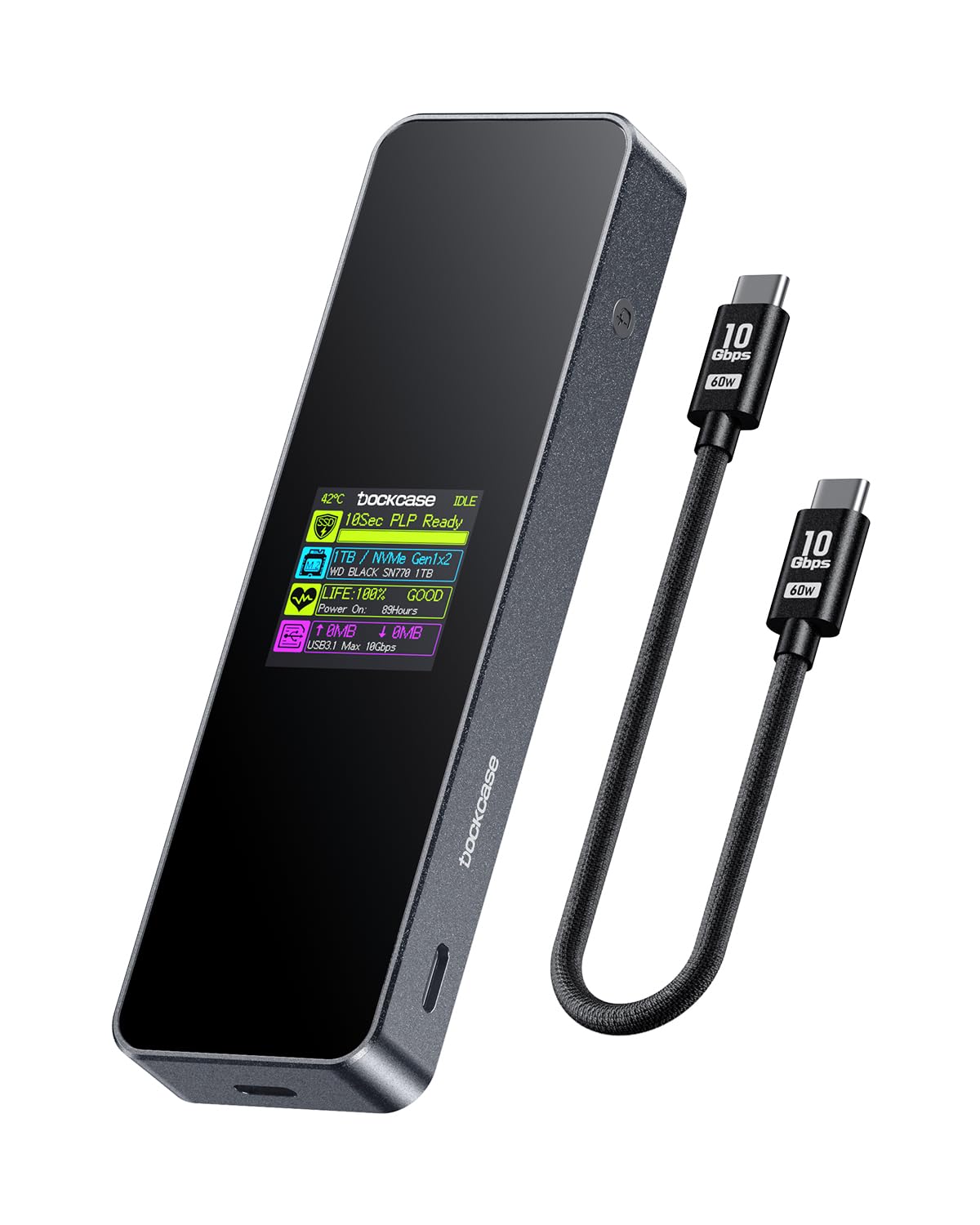







🚀 Power up your storage game with smart speed and safety!
The DOCKCASE Visual Smart M.2 NVMe SSD Enclosure combines cutting-edge USB 3.2 Gen 2 connectivity with a unique HD screen for real-time SSD health monitoring. Featuring 10-second Power Loss Protection and advanced dual heat dissipation, it ensures ultra-fast, secure, and cool operation for NVMe SSDs sized 2230 to 2280, supporting up to 2TB capacity.



N**H
Robust Aluminum Construction + Integrated Display that Shows SSD Info + Power Loss Protection
Pros:Solid chamfered-edge aluminum constructionIntegrated display shows SSD S.M.A.R.T info on demand5 seconds of power loss protectionSupports NVMe and SATA M.2 SSDsUSB 3.2 Gen 2 Type C with 10 GbpsRTL9210B controllerIncluded preinstalled thermal padCons:Limited to a maximum size of 2TB SSDsRequires a screwdriver; not a tool-less designThe Dockcase M.2 NVMe enclosure feels premium with its robust aluminum construction, complemented by chamfered edges that provide a good feel in the hand. You can confidently stow this enclosure in your backpack, knowing it will protect your SSD. It supports NVMe and SATA M.2 drives in sizes 2230/2242/2260/2280.This enclosure's standout features include the implementation of power loss protection using a capacitor and the integrated display, which provides information about the SSD's health. The enclosure's firmware can directly access your SSD's S.M.A.R.T info. Double-pressing the side button rotates the display by 90 degrees, while holding the side button brings up three additional menus: SSD Info, About Me, and Monitor.During testing, I used the Teamgroup MP34 2TB drive and connected the enclosure to a computer with a USB 3.2 Gen 2 port. I achieved impressive sequential read speeds of 956 MBps and sequential write speeds of 851 MBps, as measured by CrystalDiskMark. These speeds are more than sufficient for running an operating system or for using the enclosure as an external game drive.While the enclosure can become warm during operation, it effectively dissipates heat away from the SSD. In my tests with the Teamgroup MP34, temperatures peaked at 52 degrees Celsius. The drive never overheated and remained well below its maximum operating temperature of 70 degrees Celsius. It's worth noting that the speeds and temperatures of the installed drive may vary based on the specific port and drive being used.Overall, the unique power loss protection and integrated display make this NVMe enclosure stand out among other products in its category. The power loss protection offers peace of mind, preventing file corruption in case of sudden power loss or when forgetting to dismount the device. Additionally, The integrated display has great resolution and clarity. I would recommend this to anyone looking for a premium M.2 NVMe enclosure.
P**.
Nice enclosure
Got this to help me upgrade the internal drive on my Dell and it worked great. Nice and fast, made quick work of the 500GB or so I had to clone to my new drive. The display is a nice touch and the heatsink feels nice and hefty.
T**R
The best of the bunch, but I could wish for better
Pros:- Visual heath display with a surprising amount of data available- Has a port for external power (see Comments below)- Doesn't require one-use thermal pads, making swapping NVMe sticks easy and painless- Appears to dissipate heat well- The host has access to limited SMART data- Tech support is responsive and quite helpfulCons:- Requires UASP disabled under Linux, halving throughput- Most SMART data is unavailable, though still better than some competing brands- No support for FSTRIM (as clearly stated)Thoughts:1) This has a port to apply external power, and you probably need to use it. This is not a fault of the device, but simply because the power demands of an NVMe stick can go as high as 20w (2A @ 5v), and even my desktop system had problems pushing that much power out the USB-C port. The competing brands don't have this, in which case you'd need to insert a higher end USB powered hub between those units and your system. So2) I had lots of trouble with this unit until tech support advised me that under Linux I probably needed to turn off UASP support for this device. They call it a known Linux bug, but the Linux developers may view it differently. In any case, extra steps are required to configure your LInux system for this device, and I'm told it will cut the transmission speed in half as a result.Summary: If you need an NVMe enclosure, this is the best I've found. Functional, workable, but not the easy ride we've been use to with SSD disk enclosures that just plugged in and worked the same as if they were plugged into the mainboard directly.
P**E
Sleek, effective storage option
I bought this because I ended up with a spare 1TB NVME and my laptop storage (system drive at 1TB and data drive of 2TB) was getting filled up. I figured I would throw some of my Steam games on the dockcase NVME and could run them from either my laptop or my desktop. Works just fine for this. I haven't tried any really extensive open-world type games, but it has worked well for the games I have put on it and haven't noticed any issues as far as load times and such. It's not going to be as fast as an NVME plugged directly into your motherboard obviously, but I am happy enough with the speeds I am getting. Display is nice and even under heavy load when I was downloading a large amount of data the temps stayed reasonable.May be excessive for what I am using it for, but filled a need and overall I was happy with the purchase.
Trustpilot
2 months ago
1 month ago